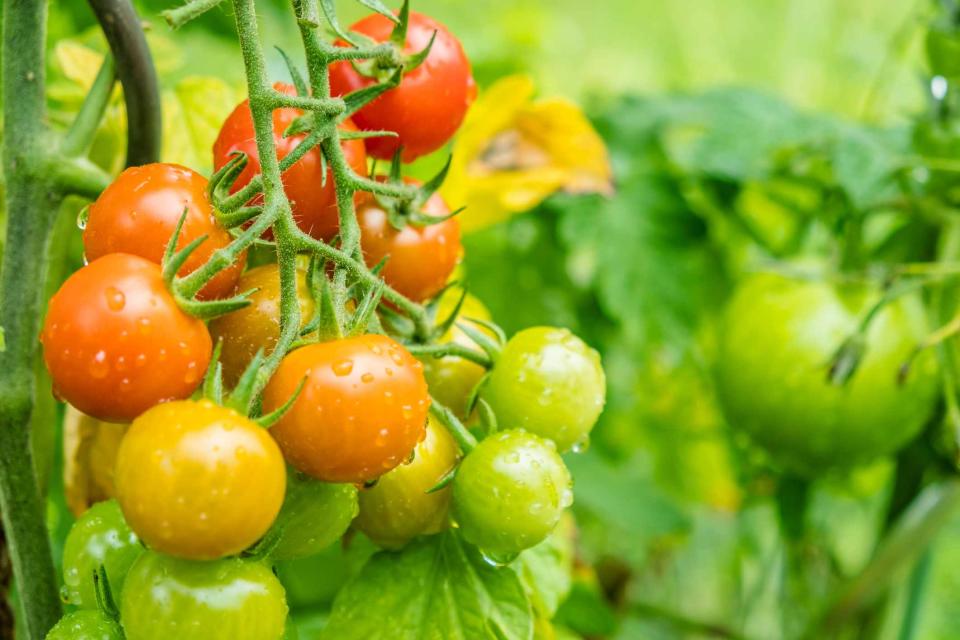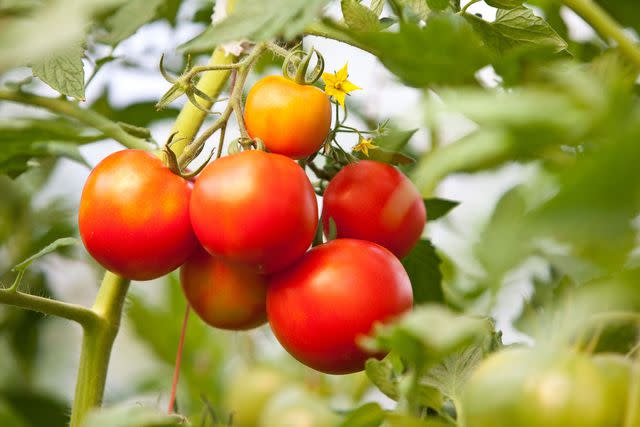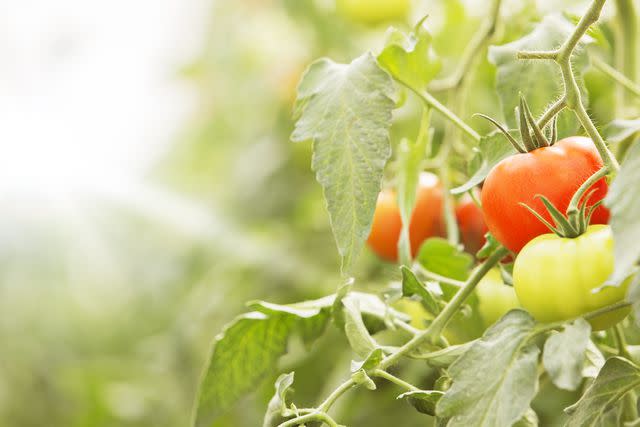9 Companion Plants You Should Never Grow With Tomatoes (And 5 You Should)
Which species are tomatoes' friends, and which are their foes?

Fabian Krause / EyeEm / Getty Images
Cherry tomatoes on the vineTomatoes are one of the most rewarding plants to have in the garden. They are relatively easy to grow, which makes them great for beginning gardeners while still offering a challenge to established green thumbs. If all goes well, they produce gorgeous fruit to eat in sandwiches or throw on pasta. However, before you start cooking and eating your harvest, you must get your plants to grow. One of the best ways to make sure your tomato plants thrive is to surround them with companion plants that can offer soil enrichment and diversification of root systems, as well as management of pests and diseases. Companion planting also helps to keep incompatible plants (those that would rob them of nutrients, block their sun, attract disease, or otherwise harm them) away from each other. Here are plants to avoid growing near tomatoes, and some that you might think about adding to your garden.

Companion Plants To Avoid Growing Near Tomatoes
1. Cabbage
Planting a member of the brassica family, like cabbage, can stunt the growth of your tomato plant because they out-compete them for the same nutrients. Cabbage and tomato seeds both need a lot of nutrients to thrive, so the competition makes one plant suffer—and that's usually the tomato. In this case, tomatoes may not produce buds, resulting in no fruit and a wasted harvest.
2. Corn
Corn and tomatoes may be great when combined in the kitchen, but not when planted together. This is because they both attract the same sort of pests and fungal infections. Moth larvae feed on both corn and tomato crops, which can destroy any possibility for growth. Putting the vegetables near each other in a garden makes them doubly attractive to bugs, and that will cause double the problems for a gardener hoping for a big harvest.
3. Broccoli
Broccoli, another vegetable in the brassica family, isn't a good choice for planting alongside tomatoes. That's because tomatoes are notoriously hungry for nutrients, and broccoli will compete for the same selection of nutrients in the soil. Both plants are heavy feeders, so planting them separately is your best bet if you want them to thrive.
4. Fennel
Like brassicas, fennel will inhibit the growth of tomatoes. Fennel isn't a good companion for most garden vegetables and should be grown in a little patch or pot by itself. "Don’t plant near bush beans, kohlrabi, or tomatoes because it inhibits their growth," according to the Colorado State University Extension Service. This licorice-scented plant may work well with other vegetables in your recipes, but not in the garden.
5. Dill
While many herbs grow well with tomatoes, dill is an exception. Young dill plants can actually do quite well next to tomatoes because they are known to help repel aphids, a tiny pest that affects many plants in the garden. However, when dill matures and is ready to seed, the herbs can inhibit tomato plant growth. The mature plants can easily damage the roots of the tomatoes and stunt their future development.
6. Potatoes
Tomatoes and potatoes are both members of the nightshade family, meaning they need the same nutrients to grow. According to the University of Arkansas Division of Agriculture Research & Extension Service, "Potatoes resemble tomatoes more than the other family members and often share the same disease and insects." If planted together, they will compete with each other, which doesn't benefit either species and can actually make them susceptible to the same diseases. These diseases can spread through the soil and ruin both plants if one is affected. Also, the proximity of these two plants matters as tomato roots can be damaged when harvesting.
7. Eggplant
Like potatoes, eggplant is in the nightshade family, which making them a competitor to tomatoes. Eggplant is also susceptible to blight, a fungal disease that can rapidly spread through a harvested area via spores blown by the wind. Planting them together makes any tomatoes planted nearby more vulnerable to blight. When sudden browning, yellowing, spotting, or dying leaves appears on crops, this is a potential sign of blight.
8. Walnuts
Choosing to plant tomatoes near a walnut tree may also negatively affect your crop. Walnut trees release chemicals in the soil that stunt the growth of surrounding plants. According to the NC State Cooperative Extension Service, "Tomatoes might grow successfully in the vicinity of a black walnut tree for a while but as the tree grows, so do its roots and eventually the roots will reach the garden." Once walnut wilt strikes, it won't take long for the disease to affect the tomato's fruits, and then the entire plant.
9. Cauliflower
This is another brassica to avoid when seeking out companion plants for your tomatoes. Cauliflower and tomatoes both feed heavily on the soil's nutrients. If they're planted close together in the garden, their competition for nutrients will likely result in smaller, less healthy plants. Keep them separate to ensure more opportunities for plant growth and produce development.

Plants That Thrive As Tomato Growing Companions
1. Asparagus
Asparagus and tomatoes are the dynamic duos of the garden. With the help of the chemical solanine, tomatoes deter obnoxious asparagus beetles, which, can do harm to asparagus plants. According to the University of Minnesota Extension Service, "The common asparagus beetle and the spotted asparagus beetle feed on asparagus spears and cause browning and scarring." A symbiotic relationship exists between the two plants, because asparagus plants, in turn, repel nematodes in the soil. An infestation of nematodes can harm the plants by attacking tomato roots and inhibiting their growth.
2. Chives
Not only are chive plants delicious herbs to have in the garden, but they can repel aphids, nematodes, and mites, making them excellent companion plants for tomatoes. They are members of the allium family and can help keep your tomatoes safe from pests by emitting a strong onion-like fragrance. According to the University of Minnesota Extension Service, "Chives thrive in full sun and well drained soil rich in organic matter. Their grass-like hollow leaves have a mild onion flavor and are common in salads and dips."
3. Lettuce
If you're planning a garden that will provide you with salad stuffs, you're in luck, because lettuce and tomatoes are happy companions in the garden. When you plant lettuce near tomato plants, you will create a ground cover that will help keep the soil moist and cut down on weeds (and weeding). In return, the shade cast by rising tomato plants can help provide some protective cover for the lettuce and stop it from bolting (flowering, which turns the leaves bitter and dry) during the heat of summer.
4. Marigolds
The bright blooms of marigolds attract insects like bees and ladybugs, which are good for a garden, but they also keep away pests like aphids, slugs, tomato worms, and snails, all of which love to munch on your growing tomato plants. These helpful plants also help keep the soil healthy for tomatoes. According to the University of Minnesota Extension Service, "A few studies show that basil and marigolds can be effective at reducing thrip populations in tomatoes in both field and greenhouse conditions."
5. Basil
Basil and tomatoes are friends in the kitchen, and they can be chums in the garden too. "Basil is a great indicator plant for tomatoes," as described by the TexasA&M AgriLife Extension Service, "Basil will show powdery mildew and other diseases before it shows on a tomato plant. It may be too late to spray if you wait until the disease shows up on the tomatoes." According to the University of Minnesota Extension Service, "Intercropping with basil may even help to promote tomato growth."
For more Southern Living news, make sure to sign up for our newsletter!
Read the original article on Southern Living.

